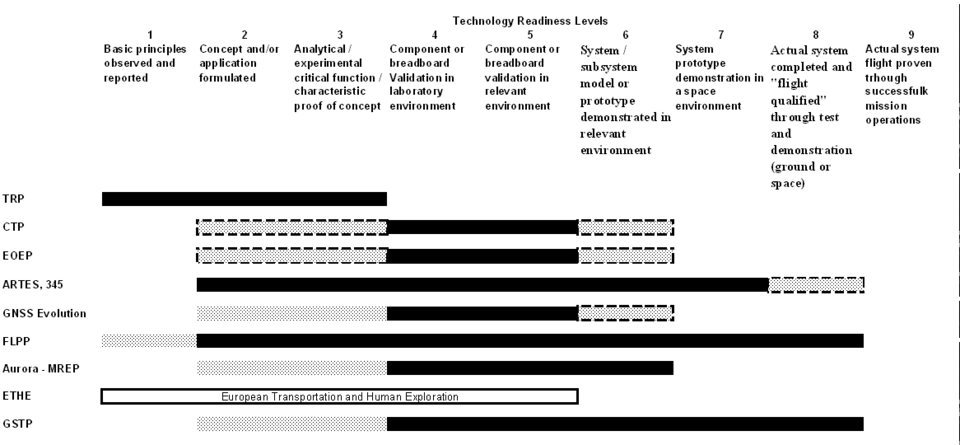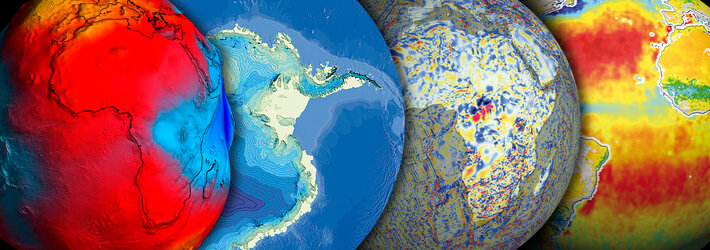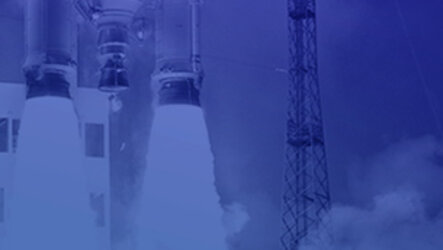About ESA technology programmes
What are they?
The development of technology – making new things to do new things – is central to ESA's existence. The Agency spends around 8% of its budget on direct research and development, an activity mandated in the ESA Convention. It runs a suite of preparatory programmes covering various different technical maturity levels and domains.
- The Basic Technology Research Programme (TRP) is responsible for early development stages across all service and technology domains, taking cutting-edge ideas and testing their suitability for space applications.
- The General Support Technology Programme (GSTP) takes previously proven innovations through to succeeding stages of engineering, finally evolving fully-tested hardware ready for adoption by future missions.
Other technology programmes serve specific fields:
- the Advanced Research in Telecom Systems (ARTES) programme supports the evolution of satellite telecommunication systems and services.
- The Future Launchers Preparatory Programme (FLPP) develops new technologies and capabilities for European launchers
These four programmes between them make up about three quarters of ESA technology R&D. Additional ESA programmes with a strong R&D component include:
- The Earth Observation Envelope Programme (EOEP)
- The European GNSS Evolution Programme (EGEP)
- The Human Exploration and Transportation
- The Science Core Technology Programme (CTP)
- The Mars Robotic Exploration Preparation (MREP)
For more information on the above programmes please refer to the left navigation.
Why are the technology programmes needed?
The programmes serve both to help define ESA's future technology needs and also eventually fulfil them.
The programmes serve both to help define ESA's future technology needs and also eventually fulfil them. Innovative technologies open up new possibilities for space missions and applications.
Spacecraft are among the most high-performance machines ever constructed – they have to be, in order to routinely operate for years in the unforgiving space environment. To maintain this level of performance any new technology must be known inside out before being considered for spaceflight.
The programmes also have the no less important purpose of preserving and expanding the technology base of European industry, ensuring its competitiveness and giving rise to commercial products and services. Space sector know-how is like muscle tone – the general rule is use it or lose it.
How are the programmes implemented?
A new technology proposal is first explored in general terms, usually within the multi-domain TDE. Once validated as a workable concept, the proposal is considered in terms of a specific application, and transfers to the next-stage General Technology Support Programme (GSTP) or another domain-specific follow-on programme.
It then undergoes a progressive sequence of ever-more complex (and expensive) development and evaluation until mission planners become sufficiently confident the technology will deliver as planned that they accept it for flight.
Operating in an efficient and timely manner, the programmes ensure that new technologies are there ready and waiting for the actual missions intending to employ them. ESA employs a scale, first proposed by NASA, of Technology Readiness Level (TRL) as a way to measure each technology's maturity, from '1' meaning 'basic principles demonstrated' all the way up to '9', for 'flight proven'.

These work plans are drafted by the Technology Network (TECNET), formed of eight groups of senior ESA experts overseeing each service domain that take into account the needs of ESA and other European missions and of industry. This process is presided over by the Directors' Sub-Committee for Technology, reflecting the high priority the Agency gives to technology development. These experts also establish the strategy and long-term for technologies.
What benefits do they deliver?
The work of the programmes also maintains and expands the capabilities of the European space industry
Progressively transforming initial proposals into flight-ready hardware, ESA's technology programmes are responsible for a steady stream of innovations that determines the Agency's future course. Their varied outputs enable ever more advanced space missions and systems, enlarge our knowledge of the universe and put space to work for European citizens.
The work of the programmes also maintains and expands the capabilities of the European space industry – a key reason for ESA’s existence. Despite receiving low investment compared to its US equivalent, Europe's space sector by itself is a significant source of high-value employment – it provides more than 28,000 jobs – and remains highly competitive, for example winning almost 40% of all 2007 geostationary comsat contracts.
The space sector is one of the highest value-added elements of the European economy. One recent analysis of the British space sector by Oxford Economics found that every space-industry job indirectly supports three additional jobs in other sectors. Space R&D has in the past given rise to entire industrial sectors, such as direct-to-home satellite television.
High-performance space technologies typically find uses on the ground, as ‘spin-offs’ employed by terrestrial businesses to improve existing products or create new ones, strengthening the overall competitiveness of European industry.
Ultimately the programmes’ creation of cutting-edge technology and fostering of technical skill contributes to Europe’s aspirations to be a knowledge society, in which an increasing share of overall wealth created through inventiveness and know-how.
How to participate?
Much of the actual technology R&D is performed by European and Canadian businesses and universities awarded ESA research contracts – 90% of all Agency spending goes on contracts with industry and academia with around 1000 contracts issued per year.
As a general rule, participation in ESA procurement of R&D actions is open to all firms (including institutes and universities) of Member States subscribing to the programme concerned on a basis of open competition, with some exceptions.
ESA regularly issues Invitations to Tender (ITTs) for programme projects on its ESAstar website. To read and respond to the ITTs requires registering with esaStar. For full details on the registration and application process, visit the ESA Industry website.
ESA is always responsive to industry and on the lookout for good ideas. For more information please refer to our 'Technology business opportunities' web pages.













